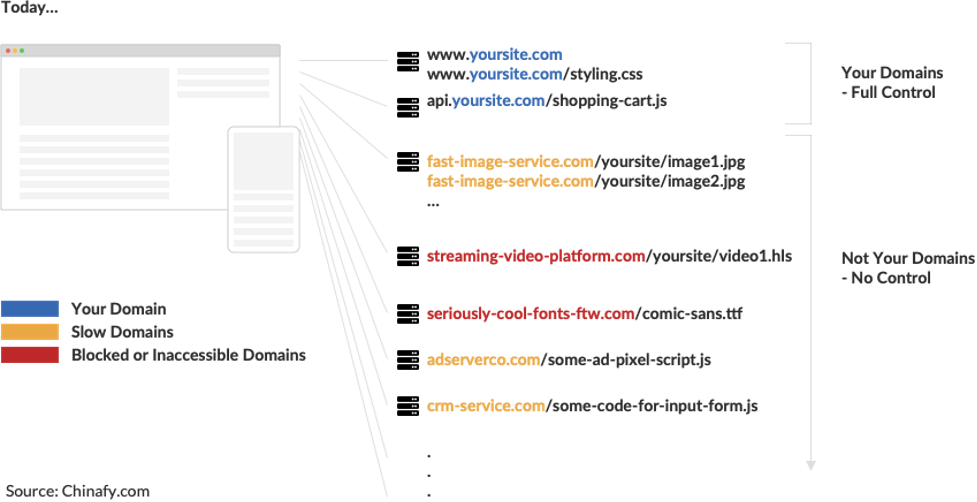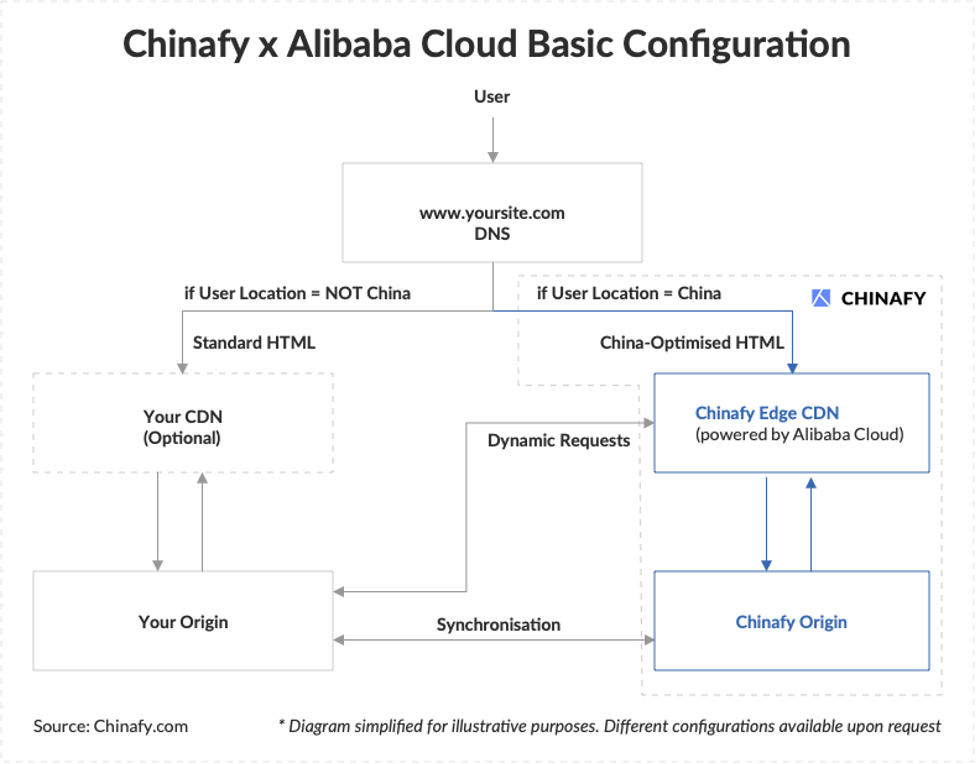In today’s competitive digital markets, time is money. Slow sites aggravate visitors, and when content renders slowly, or worse, fails to load, it’s a frustrating experience that reflects not only poorly on the brand but also forces potential customers to go elsewhere. For offshore businesses - especially MNCs, E-commerce, Travel, and Technology companies unable to host onshore - slow website performance is unavoidable having a considerable impact on the user experience, SEO, and ultimately, revenue - unavoidable, that is, until now.
Web performance, or “webperf” as it’s commonly referred to, is the science of website acceleration. While often technical and multifaceted, it traditionally revolves around:
The problem with web performance best-practices however is that they assume a somewhat homogeneous internet absent any national boundaries. While situating multiple data centres across the globe helps with data transmission speeds, connectivity, content filtering, and accessibility are different from country-to-country. For this reason, webperf practices often break down when met with emerging markets or countries with more defined content filters.
Let’s get right into it...
Not really. Well, partially. We need to distinguish between accelerating data transfer (i.e. what CDNs commonly do), vs accelerating a website, that is, webperf as mentioned above.
Alibaba’s Content Delivery Network, has over 2,800 nodes around the world with 2,300 deployed locally inside mainland China. Outside the mainland, they have nodes in nearby cities including Seoul, Tokyo, Osaka, Hong Kong, Macau, and Taipei.
While adding a CDN to your stack can definitely increase the speed at which data is transferred into China, we need to go back to webperf as a whole to understand the impact on websites. We need to look at how web pages are constructed, and which part of the pages are typically accelerated in order to understand how accelerating data throughput, and bandwidth is different than accelerating a website as a whole. For this, we need to look at the evolution of websites.
Websites, and in particular, web pages typically consist of 100s of various components or resources. These components range from the more visual file types like images, and fonts, to raw code like the HTML itself, Javascript or CSS, and to other more complex components bundled together like Maps, and Videos inserted into the page via Embeds. Many of these are static in nature. However, sites often have a number of dynamic components including those related to advertising, personalisation, or more generically, the user’s session.

In the past, websites were rather basic, and all the content was delivered via a single domain, the primary domain: www.yoursite.com. Upon requesting www.yoursite.com, a number of actions related to session initialization are kicked off namely:
Following this, the browser would then request files from the server as appropriate.
With many site’s DNS located far away, the session initialization would often take between 1-3 seconds. With the origin servers similarly located far away, these sites were slow both outside, and inside China.
As Cloud technologies evolved, CDNs became more widely adopted. Concurrent to this however, countries started formulating their own plans for the internet with many curating, or regulating access for security, content, or other reasons. This is known as the splintering of the internet or Splinternet where over the course of Youtube’s life, for example, it’s been restricted or blocked in almost 30 countries including China, Denmark, Finland, Germany, Thailand, Indonesia, and more.
At the same time, MarTech and SaaS experienced a boom, with numerous pixels, plugins, and dynamic components inserted into pages to enhance, optimize, and measure the user experience. While websites were now much quicker, the pages themselves started to get bloated with higher-definition images, richer experiences, and countless 3rd party components.
It’s at this point, where the bifurcation in the internet becomes more apparent from a performance perspective. The more 3rd party components a website relied upon, the less accessible it became in China.
Today, sites are increasingly far more multifaceted and dynamic. At the same rate, user expectations around performance are incredibly high with the impact of speed on revenue being not only widely understood, but make or break for many.
With the various plugins, marketing tools, pixels, and analytics available, many sites have in excess of 80% of the components actually hosted on 3rd party domains run by different companies, each with their own choice of content delivery network (or lack thereof).

Today, the images placed on a ‘fast-image-service’, are actually slow in China. That Youtube video that delivers training or highly-engaging visuals doesn’t load, and the fonts are hosted on an inaccessible domain. Further to that, the input form to acquire leads into your CRM system is both on a super slow server, and render-blocking preventing other visuals from displaying.
What used to take 3 secs to load in the US, takes not only 20 secs to load in China, but it’s inconsistent, with large components of the pages broken, or missing.
Let’s consider Shopify in China for a moment - Shopify has a vast marketplace of plugins offering a wide variety of services for their ecommerce companies with the average site relying on roughly 40 other domains to deliver their pages. If the average site requires that the user initialize sessions with 40 different domains, and if each of these domains takes 1-3 seconds, you’re looking at cumulatively 40-120 seconds before the first file is even downloaded. Granted - many of these requests are asynchronous (i.e. happen concurrently), but nonetheless let’s address where we are now.
We know that offshore sites:
Herein lies one of the major issues. You have control over your own domain, but
It’s not feasible to build the entire site from scratch (though many companies do so and regret it), it’s also not possible to replace all those 3rd party services. If you’re one of the lucky few who can host onshore (with the requisite licenses), it doesn’t make sense to mirror your database, web server, and front-end, with the front-end so reliant on 3rd parties.
Whether you’re hosting with Alibaba’s ECS (onshore, or offshore), or perhaps your own cloud provider, this hosting only addresses the assets delivered on your primary domain: www.yoursite.com, or subdomains: api.yoursite.com. You can consider enhancing dynamic queries by using their Global Accelerator, as well as accelerating static file delivery with their CDN, but a few issues still remain:
That’s where Chinafy’s partnership with Alibaba comes in.

Chinafy, bolts on top of your site, dynamically re-engineering both the front-end code and re-architecting the China-specific infrastructure for an end-to-end, no-touch, full site acceleration solution. The automations and optimisations include:
In the past, you’d have to rebuild an entirely new site from scratch using circa 2000 web development, and modern-day Chinese best-practices. You’d then need to find a way to synchronise content between the two sites - and for large companies, with considerable administrative overhead, this isn’t a cost-effective, nor easy task.
Chinafy adds geo-ip based redirection at the DNS so that non-Chinese users go directly to your site as originally intended. For China however, Chinafy scans your site, optimises the code (HTML, JS, CSS), delivers content quickly via Alibaba’s infrastructure, and automates the entire process so that future updates are addressed and remediated on an ongoing basis.
Once a site has been configured for, it can undergo significant changes including daily updates, new blog posts, new videos, A/B testing, signed-in areas with user-centric cookies, all free of worry in China.
Together, with Alibaba Cloud, we’re able to offer seamless, onshore-like speed and reliability, with an offshore site.
For more, check out our listing in Alibaba’s Marketplace here, or visit chinafy.com
Author
Kevin Lepsoe
CEO & Founder of Notey Labs

21 posts | 12 followers
FollowHaemi Kim - June 15, 2021
Alibaba Clouder - January 31, 2019
JDP - November 19, 2021
Alibaba Clouder - January 5, 2021
Alibaba Clouder - June 24, 2020
Iain Ferguson - January 13, 2022

21 posts | 12 followers
Follow Web Hosting Solution
Web Hosting Solution
Explore Web Hosting solutions that can power your personal website or empower your online business.
Learn More Web Hosting
Web Hosting
Explore how our Web Hosting solutions help small and medium sized companies power their websites and online businesses.
Learn More ICP Support Solution
ICP Support Solution
Learn how to obtain an ICP Filing or ICP Commercial License to host your website in Mainland China.
Learn More Web App Service
Web App Service
Web App Service allows you to deploy, scale, adjust, and monitor applications in an easy, efficient, secure, and flexible manner.
Learn MoreMore Posts by Marketplace